St. Patrick’s Day is surrounded by good intentions, misconceptions and green dye. By learning about the man behind the holiday, as well as the cooking and culinary traditions of Ireland, you may be inspired to host your own St. Paddy’s Day gathering that could include a history lesson (trivia contest!), a home-cooked Irish-inspired menu and a toast to good health.
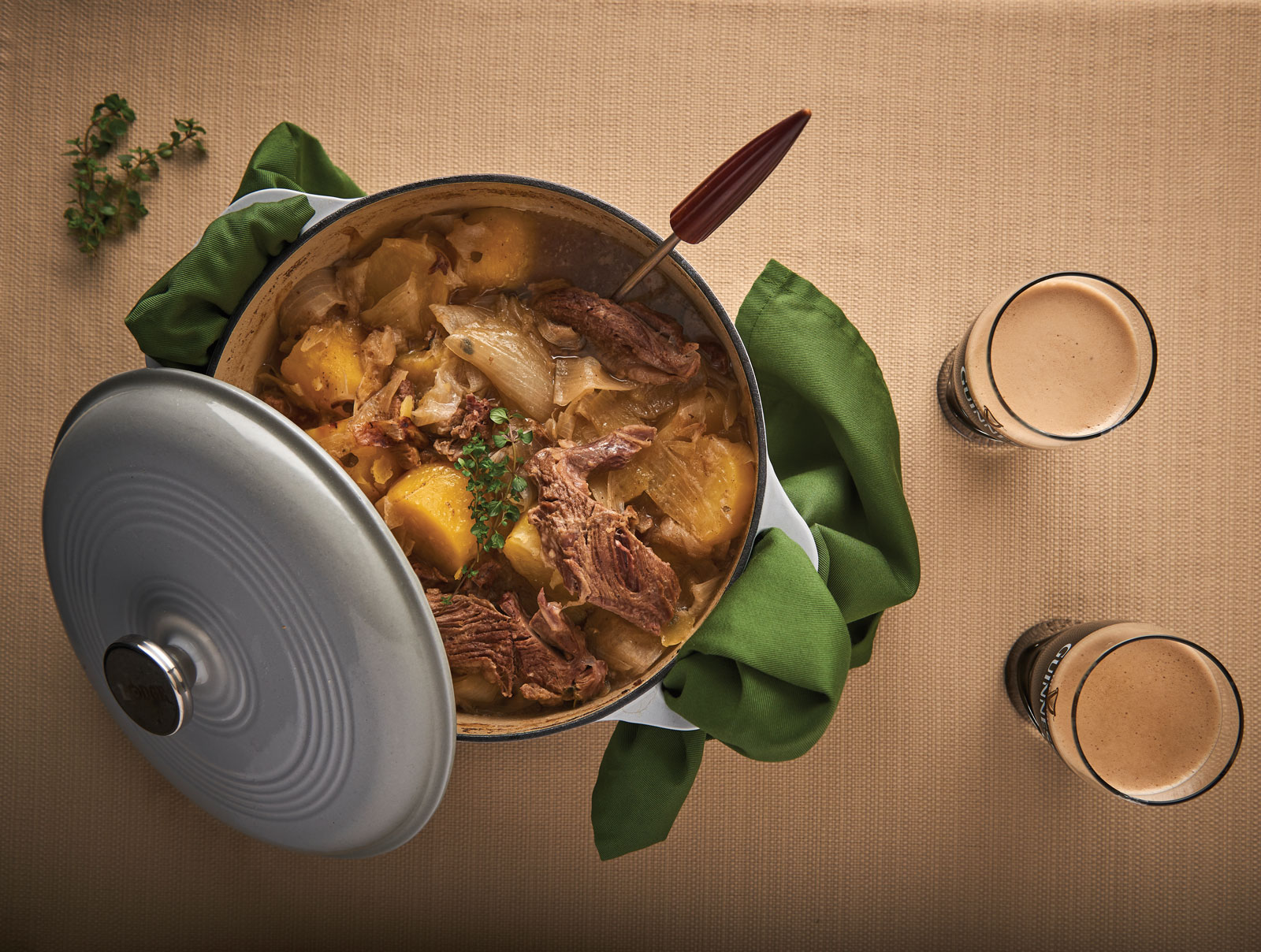
On the menu: Traditional Lamb Stew, from The Irish Cookbook by JP McMahon, is simple yet decadent. Lamb shoulder on the bone eliminates the need for stock, broth or searing the meat to coax out rich, savory flavors with a slow cook over low heat. Accented by sea salt, fresh thyme and sweet notes of onion and hearty potatoes, serve it with pours of Guinness Draught Stout.
St. Patrick’s Day History and Lore
First, a little history is in order. St. Patrick, who is the patron saint and national apostle of Ireland, was born in Britain during the fourth century. At the age of 16, he was captured and enslaved by Irish pirates. He credited his strong faith as the reason he was able to endure six years of enslavement. Upon his escape or release, he made his way back to Britain, where he became a priest.
A recurring dream compelled him to become the “voice of the Irish.” While he is credited with introducing Christianity to Ireland (he used the shamrock to explain the concept of the Holy Trinity), he was beloved by Christians and non-Christians alike. Legends surrounded him, including the tale that he drove all the snakes out of Ireland (not true). St. Patrick’s Day, which was initially commemorated as a religious feast in 1631, paid homage to his death date, March 17, 461 A.D. St. Patrick’s Day became an official national holiday in Ireland in 1903. Dublin’s first St. Paddy’s Day parade stepped off in 1931.
Irish émigrés to the United States are credited with transforming St. Patrick’s Day on this side of the pond into a secular holiday. Boston’s first St. Paddy’s Day parade dates to 1737, while New York’s was launched in 1762. Homesick Irish soldiers serving in the British Army are credited with organizing them. St. Patrick’s Day is also celebrated in grand style in Chicago, where the Chicago River has taken on a green hue on March 17 since 1962. Today, bars and restaurants nationwide join in celebrating the holiday with special menus and parties, even if they serve Latin, Asian, Italian, Greek or down-home American food on the other 364 days of the year. After all, as the saying goes, everyone is Irish on March 17.
Cooking
Yes, we’re familiar with shepherd’s pie, corned beef and cabbage and other Americanized Irish dishes. But, there’s so much more to explore from a culinary standpoint.
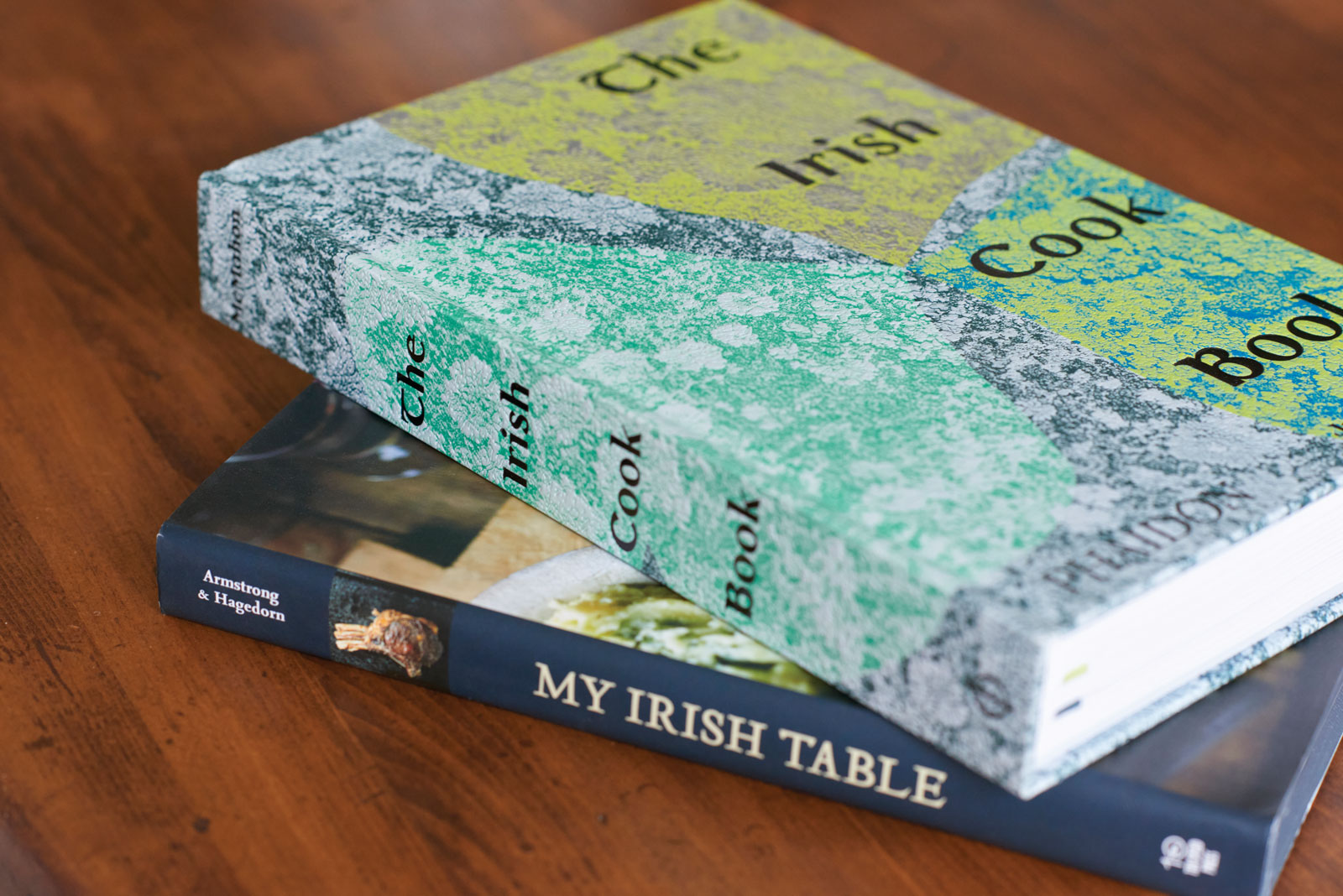
If you plan to cook at home on March 17, you’ll need some inspiration. The Irish Cookbook by Chef JP McMahon, published in 2020, offers bits of history, context and spectacular photographs paired with hundreds of Irish recipes. McMahon reaches into the deepest depths of Irish history, examining the evolution of Irish foods and how they became defined as Irish. Another book I like is My Irish Table: Recipes from the Homeland and Restaurant. Written by Cathal Armstrong and David Hagedorn, it offers recipes of classic, traditional Irish dishes.
The Irish Cookbook by Chef JP McMahon, published in 2020, is a gorgeous cookbook offering historical context of Irish food. Some recipes are more approachable than others, but all are thoughtful and are paired with spectacular photographs. (Follow him on Facebook and Instagram @mistereatgalway.)
McMahon reaches into the deepest depths of Irish history, examining the evolution of Irish foods and how they became defined as such. He champions the wild, seasonal and sustainable ingredients that especially define western Ireland. His Michelin-starred restaurant, Aniar, in Galway, is regarded as a beacon for contemporary Irish cuisine.
In his book, Chef McMahon draws attention to the stereotypical potato as a relative latecomer in Ireland’s history, which spans thousands of years. From Celts to Romans, Normans to Vikings, there were many, often dramatic influences bringing change to Ireland. Thus, he defines Ireland as “the ultimate melting pot” in regards to Irish cuisine.
The potato occupies a critical point in history, preceded and marked by The Great Famine, which had as much to do with oppressive English rule as it did with diseased potatoes. “There was plenty of food in Ireland,” writes McMahon. “It was just not available to the starving tenement farmers and peasants who had relied solely on the potatoes to feed themselves. More food was exported out of Ireland during the famine than before it,” he continues. “Masses of corned beef and barley left the island to feed people elsewhere. The potato was therefore a blessing and a curse for the Irish people. A small patch of potatoes could sustain a family, but over-reliance meant that the failure of the crop contributed to the deaths of a million people and the emigration of as many between 1845 and 1951,” writes McMahon.
At the time, the potato variety known as the “Irish Lumper,” was predominantly grown and was particularly vulnerable to blight. The plant disease was not exclusive to Ireland, but the forced dependency on the potato amplified starvation through taxation and suppression.
“The potato’s role as a stereotype of Irish food has obscured other valuable products,” writes McMahon. For example, the availability of freshwater fish, eels and access to drinking water led to early settlement of river regions. Seafood such as saltwater fish, oysters, lobster, squid, muscles, crabs and seaweed are in abundance. Cultivated and foraged produce such as artichokes, plums, asparagus, carrots, leeks, mushrooms, nuts and berries abound. Hare, wild venison and domesticated livestock such as chicken, sheep and cattle that were brought to Ireland by settlers and invaders over thousands of years also define Irish cuisine.
Irish Butter
Television viewers may have noticed a story-like commercial that has aired over the past few months. The star of the commercial is Kerrygold Pure Irish Butter. Historically, those living in cooler climates in northern Europe relied on butter to preserve fat, whereas those living in warmer, southern and Mediterranean climates, were blessed with plentiful sources of olive oil.
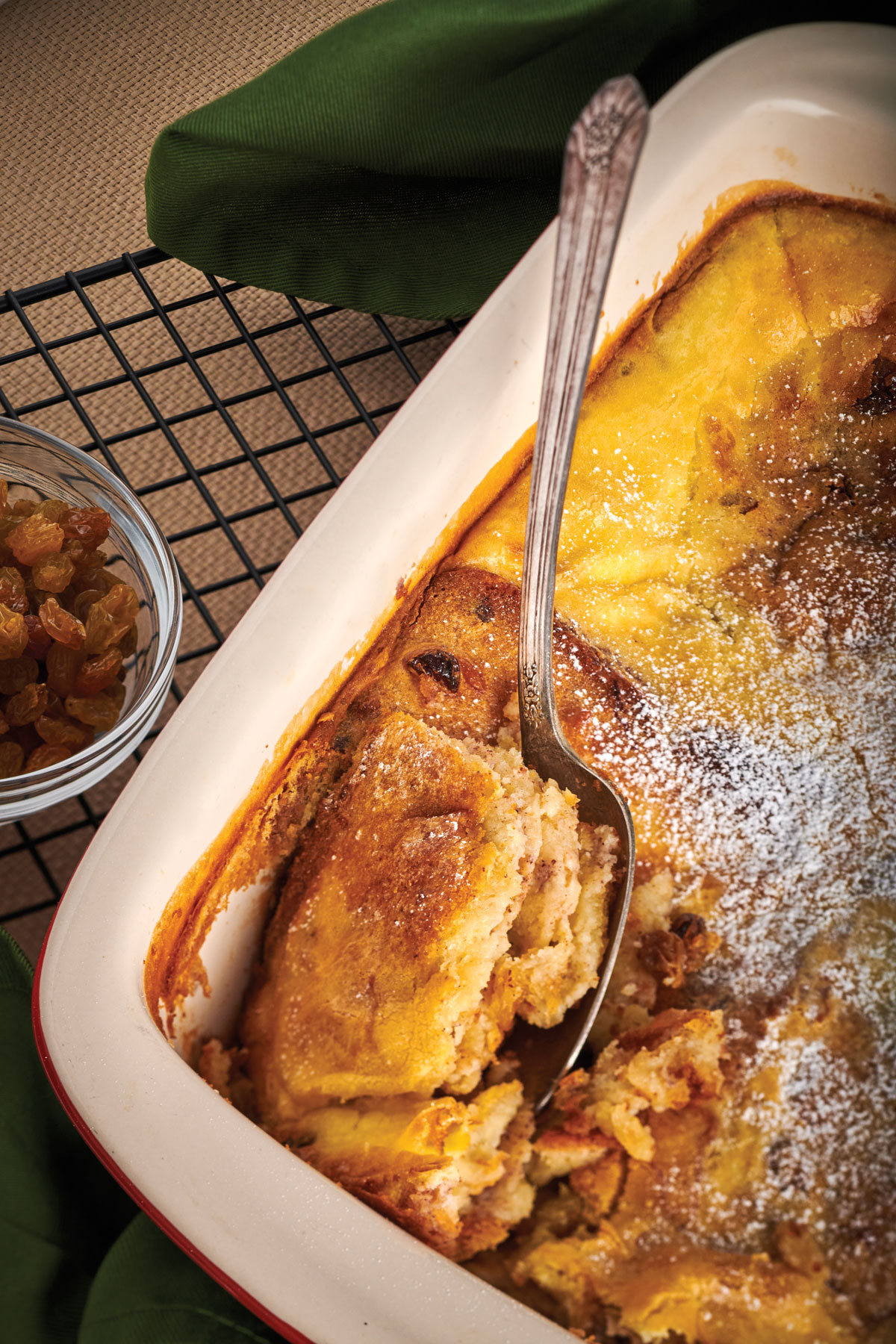
Bread and Butter Pudding from The Irish Cookbook by JP McMahon. Slightly chewy and buttery, warm baking notes – provided by cinnamon and nutmeg – are a highlight of the custard. The golden raisins (sultanas) are tender and sweet, blending in with the bread pudding. I’d recommend doubling the custard in the recipe when using thick slices of bread. Also, store the butter (I used Kerrygold Pure Irish Butter, which is available in most grocery stores) at room temperature for easy spreading, holding an extra slice of bread while buttering to make the process less messy. Serve hot in a bowl with a splash of milk.
With ample rainfall, grass grows lush and tall in Ireland, providing food for milk-producing cattle. Irish butter, such as the aforementioned Kerrygold, is higher in milk fat. Clocking in at 82% milk fat – compared to the traditional 80% milk-fat content of butter produced in the U.S. – and containing less water, Irish butter has a higher concentration of flavor while offering a soft, creamy texture that spreads easily. In baking, fat content translates into flaky, airy textures found in the laminating process. A byproduct of butter-making is buttermilk, which is used in Irish soda bread, as well as meat marinades for poultry and wild game.
Irish butter is wonderful on morning toast. Serve it with breakfast tea, which offers higher concentrations of caffeine. Irish breakfast tea is particularly robust in flavor; adding milk to black tea mellows the intensity while adding a creamy texture.
Guinness
Of course, you can’t celebrate St. Patrick’s Day without a beverage. Guinness boasts a fascinating if not incredible history. Finding its start on the last day of the year in 1759, founder Arthur Guinness signed a 9,000-year lease on St. James’s Gate Brewery. Located at the site of a razed entrance through Dublin’s medieval wall, the monthly rent of £45 is still paid to the landowner. Historically, Guinness ale has been paired with seafood, especially oysters.
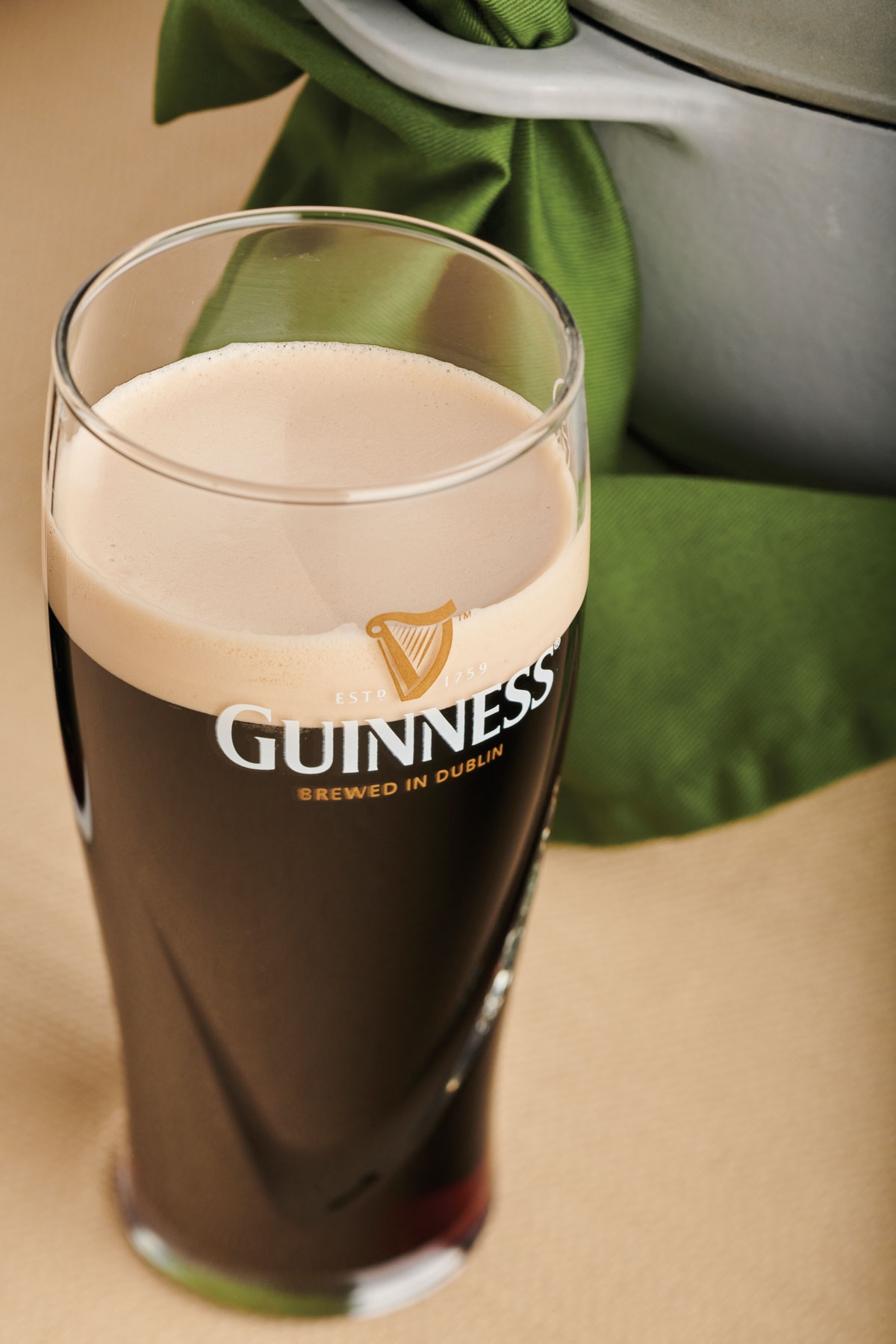
Guinness Draught Stout, imported from St. James’s Gate in Dublin, Ireland. Nitrogen fills the hopped, sweet and bitter stout for a creamy mouthfeel. Founded in 1759, Guinness introduced its world-famous stout 200 years later in 1959.
Like the potato in the scope of Ireland’s history, the famed Guinness Stout is comparatively new, originating in 1959. Guinness’ variety is brewed with hops in addition to water, barley and yeast, adding a bitter note to the sweet, creamy flavor.
Over winter, finding a case of Guinness in my garage isn’t uncommon, and the YouTube channel, Guinness Guru, is a favorite to watch while enjoying a pint. Based in Ireland, channel creator, Daragh Curran, visits pubs in Ireland, the U.K. and Europe, rating the quality and differences of individual pours of Guinness in notable, often centuries-old establishments. Guinness is brewed differently for various regions and the system of delivery varies at each storied pub. The “Guinness Guru Pint Map” showcases each of Curran’s ratings throughout Europe and the U.S.
As a note for those traveling to Ireland: a liquid pint in the U.S. is 16 ounces, whereas the Imperial equivalent is 20 ounces. Low in alcohol (4.2%) and with just 175 calories per 500 ml, the Guinness flavor is still creamy, toasty and bitter.
For more information, visit guinness.com and gurutv.ie/map1.
Peterson Pipes

Tobacco pipes from Peterson of Dublin. Established in 1865, Peterson is “the oldest continuously operating pipe factory in the world.” Quintessentially Irish and laced with tradition, Peterson’s pipes are often enjoyed after a meal.
After preparing and savoring a hearty meal, it’s time to relax! Continuing with the theme of centuries-old establishments, one of my interests is Peterson Pipes. Started in 1865 as Kapp, it later became Kapp & Peterson, and eventually, Peterson. The company celebrates St. Patrick’s Day annually with a commemorative pipe, whose design is usually announced in February. I own a few, and joining Peterson pipe groups on social media has been enlightening, with members spanning the globe, many from Ireland. Through their conversations, I’ve learned that black tea or Guinness pairs with a pipe just as well (or better) than does a dram of whiskey. Oh, and don’t forget to include a toast to health with the Gaelic word, “sláinte” (pronounced SLAHN-cha). For more information, visit peterson.ie.
Happy St. Patrick’s Day! And, don’t forget to plant your peas on March 17 for good luck in 2023.
Annie Bailey’s Irish Public House, Lancaster, anniebaileys.com
Brendee’s Irish Pub, Lancaster, brendeesirishpub.com
O’Halloran’s Irish Pub & Eatery, Lancaster, ohallspublancpa.com
McCleary’s Public House, Marietta, mcclearyspub.com
Tellus360, Lancaster, tellus360.com





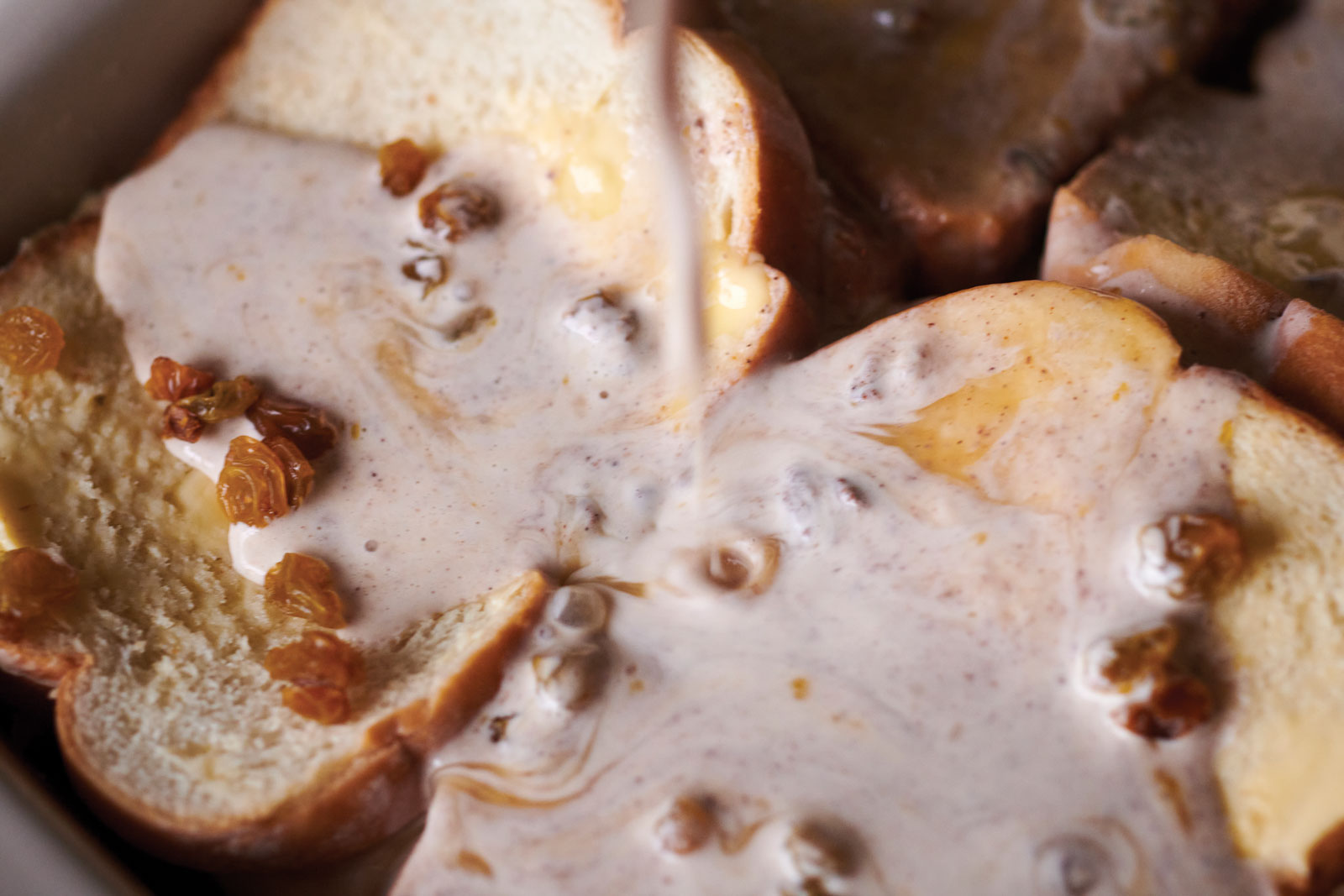
SHARE
PRINT